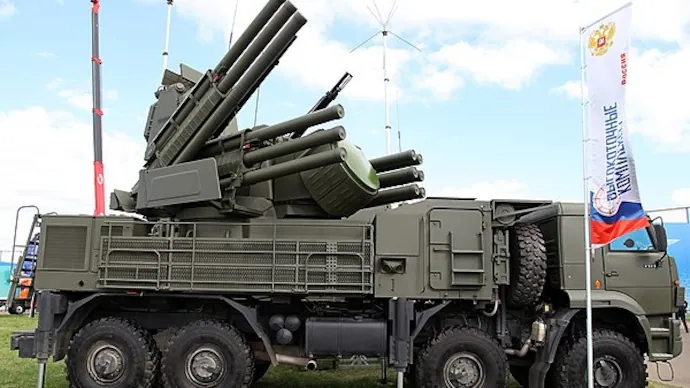India and Russia’s New Defense Agreement
India and Russia have taken a big step in defense cooperation by agreeing to jointly develop new versions of the Pantsir air defense missile and gun system. This system, a combination of missile launchers and rapid-fire guns, is designed to provide high protection against a variety of air threats, including enemy aircraft and cruise missiles. The latest agreement, signed between Bharat Dynamics Limited (BDL) of India and Rosoboronexport, Russia’s top arms exporter, aims to create a Pantsir system customised to India’s needs, strengthening the nation’s air defense capabilities.
The Pantsir System: Powerful Defense Against Air Threats
The Pantsir system is a highly adaptable air defense tool known for its ability to quickly respond to incoming threats. It combines missile launch systems with 30mm guns, making it a formidable choice for countering aircraft and low-flying projectiles. The missiles can reach targets up to 15 kilometers high, while the guns are effective up to 3,000 meters in altitude. This system is widely valued for its ability to defend key locations like military bases and critical infrastructure, giving it a dual advantage for India’s national security.
India has considered adopting the Pantsir system in the past, particularly when exploring options to strengthen self-propelled air defenses for its Army. While the system did not initially secure a contract, India’s interest has remained due to its advanced capabilities. The current collaboration indicates a strong commitment from both nations to leverage the Pantsir’s capabilities and develop variants specifically suited for India’s defense landscape.
Why the Partnership Matters for India
India relies heavily on Russian defense technology, with Russian arms comprising nearly 60% of its military’s arsenal. In 2018, India signed a major $5.4 billion deal with Russia to acquire five batteries of the advanced S-400 air defense systems, a contract that significantly boosted India’s defense posture. While three of the S-400 systems have been delivered, the remaining two have faced delays due to ongoing challenges from the Russia-Ukraine conflict. The new agreement to develop the Pantsir systems highlights India’s interest in furthering its air defense capabilities while enhancing its partnership with Russia for long-term security goals.
Expanding India’s Defense Technology
The latest agreement will involve Bharat Dynamics Limited (BDL) and Rosoboronexport working closely to create an Indian version of the Pantsir system. BDL, India’s leading state-run defense company, has extensive experience in developing advanced missile technology. By teaming up with Russia, BDL will gain valuable insights into the Pantsir system’s structure and operation, leading to potential advancements in Indian missile and gun defense technology. The agreement aligns with India’s strategy to build and strengthen its defense systems locally while incorporating advanced technologies from trusted international partners.
This collaboration also aligns with India’s “Make in India” initiative, which aims to boost the country’s self-reliance in defense technology. With this initiative, India has sought to develop and produce defense equipment domestically, reducing dependency on foreign suppliers while fostering local industries. A jointly developed Pantsir variant represents a significant step toward achieving this goal. It could also serve as a model for other defense partnerships in the future.
Strengthening Ties Through the Intergovernmental Defense Commission
The agreement was formalized on the sidelines of a meeting of the India-Russia Intergovernmental Commission for Defense Cooperation, a high-level body co-chaired by the defense ministers of both countries. This commission plays a key role in managing and advancing defense relations between India and Russia. With the defense ministers expected to meet soon, the commission’s involvement highlights the significance of the Pantsir collaboration. It underscores both countries’ commitment to strengthening their long-standing defense partnership amid shifting global security landscapes.
Addressing Air Defense Needs in a Changing World
Air defense has become a crucial area for countries worldwide due to evolving security threats. By including advancements in missile technology and increasing airspace vulnerabilities. For India, which faces regional security challenges, having a robust air defense system is vital. The collaboration on the Pantsir variants will help address the country’s specific needs, including defending important military and industrial facilities. As India modernises its defense infrastructure, partnerships like this one with Russia will be essential for maintaining security and deterring potential threats.
Potential for Future Cooperation
This agreement could pave the way for more joint defense projects between India and Russia. Both countries have a long history of defense collaboration, and their partnership has expanded over the years. India’s reliance on Russian arms and technology remains strong, but new agreements like the Pantsir project show an increasing focus on co-development and technology sharing. This approach allows India to leverage Russia’s technological strengths while contributing its expertise to adapt these systems for local use. By fostering a closer working relationship, India and Russia can continue to benefit from mutual advancements in defense technologies.
The Road Ahead: Preparing for Advanced Defense Systems
The new Pantsir variant project represents more than just a technological upgrade for India’s air defense—it is also a strategic move that underscores India’s commitment to regional stability and self-reliance. By 2028, the Indian government aims to reduce dependency on foreign-sourced defense equipment, and collaborations like this one with Russia are key steps toward achieving that goal. If the Pantsir project proves successful, it could open doors to further collaborative ventures and set a precedent for future co-development initiatives.
A Boost for National Defense
India’s decision to partner with Russia in developing the Pantsir system is a significant step in bolstering its air defense capabilities. As this project moves forward, it will help strengthen India’s military infrastructure, create local expertise, and solidify the strategic partnership between India and Russia. The agreement also shows India’s determination to enhance its defense systems in a world with evolving security challenges. Through continued collaboration and innovation, India is taking active steps to secure its borders and protect its interests on the global stage.

